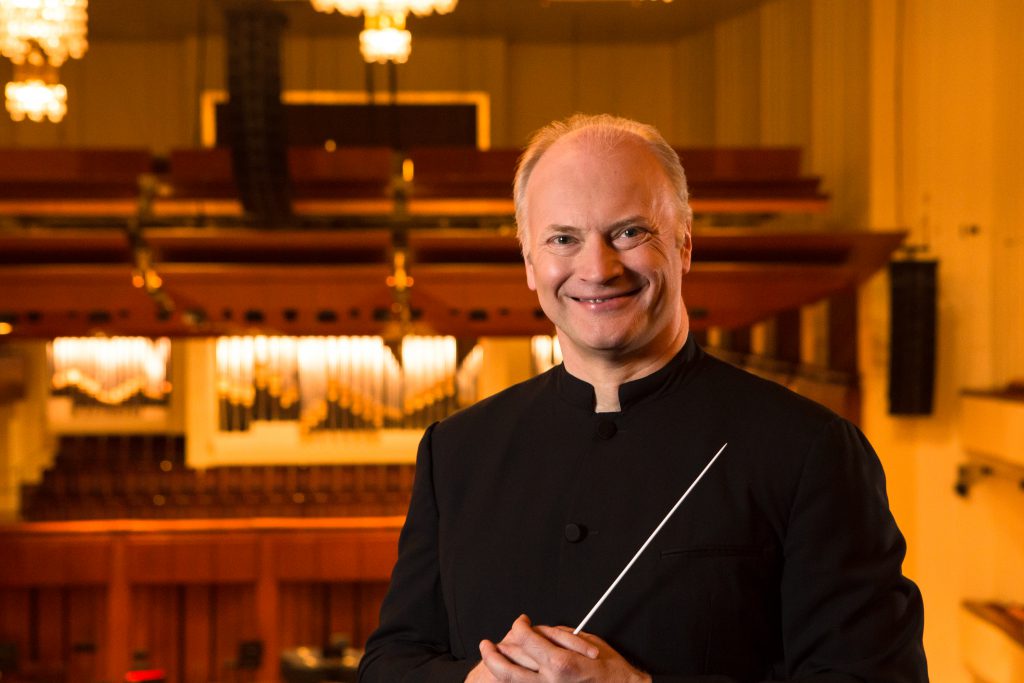Noseda offers “tasting menu” of orchestral showpieces with NSO

Gianandrea Noseda conducted the National Symphony Orchestra Thursday night in music of Gershwin, Chausson, Respighi and de Falla. Photo: Tony Hitchcock
Gianandrea Noseda is at the midpoint of a three-week stand with his new band, the National Symphony Orchestra. If last week’s program was about disrupting expectations in the classics, Thursday night’s concert in the Kennedy Center Concert Hall was more in the easy listening vein. Taking up the microphone after intermission, Noseda described this selection of four relatively short works as “finger food”–four desserts in search of a main course.
The concert was also a tour of Europe, beginning with Respighi’s Fontane di Roma, the first of the composer’s Roman-themed tone poems, premiered in 1917. Noseda helped the orchestra craft a pastel-hued dawn in the first movement, the sheen of the stratospheric harmonics in the first violins almost inaudible above the muted second violins in the opening bars. Going for maximum contrast, Noseda launched the second movement with a raucous spray of sound, his fast tempo not quite landing solidly across the orchestra.
In the third movement the brass were an imperial presence, riding atop the foundation of sound from the rumbling Kennedy Center concert organ: marked as optional in the score, the king of instruments adds something majestic to this movement’s magical orchestration. The piece then returned to more gentle sounds in the fourth movement, with shiny touches of bells, harp, and celesta, underpinning strong solos in flute and violin.
This unabashedly romantic mood was extended in Ernest Chausson’s Poème, op. 25, composed for Eugène Ysaÿe, who had asked the composer for a violin concerto. Concertmaster Nurit Bar-Josef’s warm, chocolatey tone suited the significant solo part beautifully, with ardent playing on the long melodic lines. The double-stops, an Ysaÿe speciality, were not as flawless, but Bar-Josef’s perfectly manicured trills, soft and fluttery, brought the piece to a magnificent conclusion. The NSO, which last played this piece in 2001 with Leonard Slatkin, accompanied their colleague with sincerity and attentive care.
Noseda’s inaugural season tour of American chestnuts, which began with Bernstein’s Symphonic Dances, continued here with Gershwin’s An American in Paris. It was the first local performance of Mark Clague’s new edition of the piece, setting it apart from Christoph König’s rendition with the Baltimore Symphony Orchestra this past summer, for example. The most obvious difference was in the sound of the taxi horns, which Clague discovered were not to be tuned to the pitches A, B, C, and D, as orchestras have been doing for decades, but to more discordant pitches sounded by the actual taxi horns Gershwin brought back with him from Paris.
Although the “klaxonology” was authentic, Noseda’s handling of the piece’s jazz-infused parts felt a little stiff and square, fast tempos strictly maintained in a way that often hampered the groove. The playing was generally fine, especially the keening English horn, and the trumpet and saxophones boozed it up gorgeously in the slow section. Acting associate concertmaster Ricardo Cyncynates provided a moment of high drama when one of his strings broke, just as he was nearing the solo duet with Bar-Josef. Unable to get a new string in place in time, he adroitly switched instruments with the violinist behind him and did not miss a beat of the solo.
The highlight of the evening was music of Manuel de Falla’s, the two suites from the ballet The Three-Cornered Hat, last played by the NSO in 1986. Premiered by Diaghilev’s Ballets Russes in 1919, with sets designed by Pablo Picasso, the ballet’s tale of a husband and wife thwarting sexual assault by a man in a position of power seems especially timely. The suites include about two-thirds of the music, minus the two songs for mezzo-soprano and most of the pantomime numbers.
Here Noseda gave the dance greater room to unfold organically, rather than trying to force it, finding a spirited quality in these charming comic dances, enlivened by Andalusian folk music. In some ways the dances felt marooned from their story, but crisply aligned ensemble precision was the fruit borne of what must have been careful rehearsal. An elegant French horn solo adorned the “Farruca,” danced by the miller for his guests in the second act.
Buoyant energy lifted the boisterous final dance, which concludes with the townspeople throwing the lecherous magistrate — and his pompous, tricornered hat — up and down with a blanket. Perhaps it would have been better to leave out the Gershwin, in favor of the complete Falla score.
The program will be repeated 8 p.m. Saturday and 3 p.m. Sunday. kennedy-center.org; 202-467-4600.
